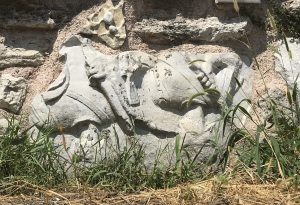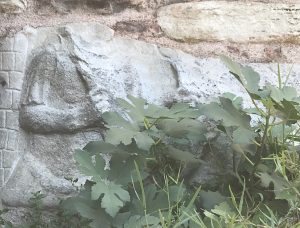 Named after the Ottoman sultan Beyazıd II (1447-1512) whose tomb forms part of the mosque complex he founded here, Beyazıt is the extraordinarily busy and congested suburb that wraps itself around Kapalı Çarsı (the Grand Bazaar).
Named after the Ottoman sultan Beyazıd II (1447-1512) whose tomb forms part of the mosque complex he founded here, Beyazıt is the extraordinarily busy and congested suburb that wraps itself around Kapalı Çarsı (the Grand Bazaar).
The old Roman Via Egnatia (the Mesa) passed through this area, transiting what was then the Forum Tauri. Today the main road running in front of Kapalı Çarşi is a continuation of Divan Yolu/Yeniciler Caddesi although this stretch is called Ordu Caddesi (Army Street). In 2024 this was closed to traffic bringing unexpected calm and wider pavements to the area.
In some ways Beyazıt is an unlucky suburb since, while probably necessary for town planning, road-widening in the 1950s made it harder to appreciate its historic layout. There are, for example, a few surviving traces of the old Forum Tauri although you could be forgiven for not noticing them.
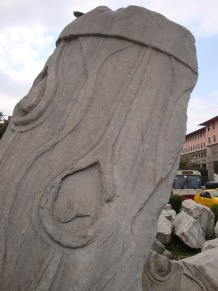 Look for the huge hunks of marble, some of them decorated with stone teardrops, sitting beside the main road – once upon a time they formed parts of a huge triumphal arch probably erected shortly after the reign of the Emperor Theodosius (r.379-395) who had the square renamed the Forum Theodosius after himself. It may once have been adorned with statues of Theodosius and his sons Honorius and Arcadius.
Look for the huge hunks of marble, some of them decorated with stone teardrops, sitting beside the main road – once upon a time they formed parts of a huge triumphal arch probably erected shortly after the reign of the Emperor Theodosius (r.379-395) who had the square renamed the Forum Theodosius after himself. It may once have been adorned with statues of Theodosius and his sons Honorius and Arcadius.
Look closely at the base of the outer wall of the Beyazıt Hamam and you will see more stones that were probably taken from the arch.
In 2024 the square was reopened after extensive re-landscaping which has made it much more inviting.
Beyazıt Cami and its külliye
Kapalı Carşı is so much the best known monument in Beyazıt that it tends to overshadow the wonderful Beyazıt Cami, one of my favourites of the early imperial mosques and known to 19th-century travellers as “the Pigeon Mosque” for the quantity of birds fed here (a function largely taken over by the Yeni Cami in Eminönü today).
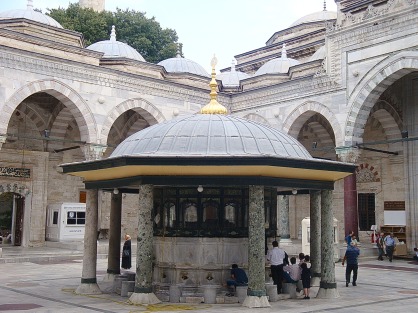 The Beyazidiye was built between 1501 and 1506 by Yakub-şah ibn Sultan-şah, a little known but probably Turkish architect who appears to have taken Hagia Sophia (Ayasofya) as his model. Like the Fatih Cami, it was built on a huge scale, and, like the Fatih Cami, it was given a marvellous porticoed courtyard, a feature that Mimar Sinan went on to perfect in the Şehzade Cami and others of his masterpieces. This courtyard makes a wonderful place to relax and watch the world go by after a frenzied visit to the Bazaar.
The Beyazidiye was built between 1501 and 1506 by Yakub-şah ibn Sultan-şah, a little known but probably Turkish architect who appears to have taken Hagia Sophia (Ayasofya) as his model. Like the Fatih Cami, it was built on a huge scale, and, like the Fatih Cami, it was given a marvellous porticoed courtyard, a feature that Mimar Sinan went on to perfect in the Şehzade Cami and others of his masterpieces. This courtyard makes a wonderful place to relax and watch the world go by after a frenzied visit to the Bazaar.
The mosque was once the focal point of a huge complex, a fact that has been made much less obvious by the remodelling of the main square in the 1950s but which you can vaguely appreciate if you look towards the square and the mosque from the far side of Ordu Caddesi. Leaving the mosque on its north-easterly side you will see what was once its imaret (soup kitchen) but was converted to house a library in 1832. This became the Beyazıt Devlet Kütüphanesi (State Library) in 1884.
On the western side of the mosque a small domed building once housed the sibyan mektebi or primary school. Right beside this is the small cemetery where Sultan Beyazıd was buried. Later the imposing tomb of the grand vizier Koca Mustafa Reşid Paşa (1800-58) was built onto the street-facing corner of the graveyard; it’s conspicuous for the metal grilles set into its walls.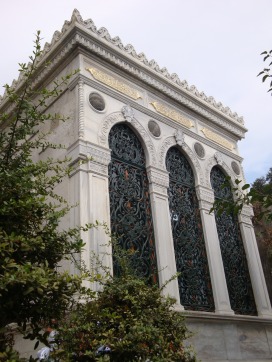 Also buried in the graveyard is Kemaleddin Bey, the First National architect whose moustachioed image appears on the TL20 note.
Also buried in the graveyard is Kemaleddin Bey, the First National architect whose moustachioed image appears on the TL20 note.
On the western side of the square what was originally the mosque’s medrese (seminary) was converted to house a museum of calligraphy but this has been “closed for restoration” for so many years that one wonders if it will ever reopen.
Down the steps from the square and a little further west along Ordu Caddesi stands the hamam (bathhouse) that was once also part of the complex. It has been turned into a small museum of bath-house history (closed weekends, admission free) which also shows off slight traces of early Byzantine churches uncovered in the vicinity. Look low down at the outside walls and you’ll see pieces of Roman carvings embedded in them.
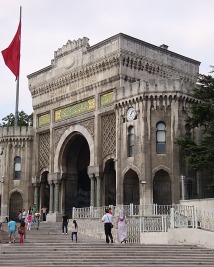 Around Beyazıt
Around Beyazıt
The bazaar and mosque aside, the most conspicuous buildings in Beyazıt are those associated with İstanbul University whose grand entrance, designed to look a little like a Roman triumphal arch, stands at the top of the steps at the back of Beyazıt Meydanı (square).
Originally the buildings were designed by Marie-Auguste Antoine Bourgeois in 1866 to house the Seraskat, or Ministry of War. The university stands over the site of the Eski Sarayı (Old Palace), the first home in Constantinople of Sultan Mehmed II that gradually turned into a retirement home for the wives of the sultans once Topkapı Palace was up and running.
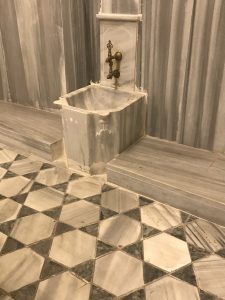
Rather like Oxford and Cambridge, İstanbul University has a very long pedigree stretching right back to the 15th century and the reign of Sultan Mehmed II. At that time the Darülfünun was housed in the medreses attached to the huge Fatih Cami, the mosque built to commemorate the all-conquering sultan. Later it was rehoused in the medreses attached to the Şuleymaniye, Selimiye and Beyazidiye mosques before finally finding its new home – and its current name – here in 1933.
It may not look as if you can enter the grounds of the university but the gatekeepers will usually let you through in which case you will be able to walk to the base of the Serasker Kulesi (Beyazıt Tower), a fire-warning tower designed in 1828 by Senekerim Balyan to replace three wooden versions that had – you couldn’t make it up! – burned down. Despite occasional suggestions that the tower will be opened to the public so that visitors can appreciate the magnificent view from the top so far this has not happened. 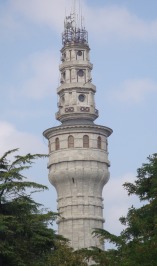
At the far side of the university grounds stands the university rectorate, a grand building whose top floor houses an art gallery dedicated to the work of Turkey’s first portrait painter, Feyhamam Duran (1886-1970), and his wife, Güzin. Here, too, are paintings by Selim Turan (1915-94). The rectorate also hosts occasional temporary exhibitions.
If you leave the rectorate by the side gate, then turn right and then left into Tasodalar Sokağı you will come to the wooden house in which Duran lived. The walls of the house are mainly covered with calligraphic panels by Duran’s father but upstairs in the bedroom there’s one especially lovely portrait of the young Güzin. Preserved in the garden is the atelier in which he and his wife produced their paintings. It’s a delightful and unexpected discovery in an otherwise grim setting although if you’re unlucky you may arrive to find no one there to let you in.
During the creation of the İstanbul University campus the remains of four small Byzantine churches dating in age from the 6th to the 11th century came to light. Some of the finds including lyre-shaped Corinthian capitals and parapet slabs are now in the Hamam Museum.
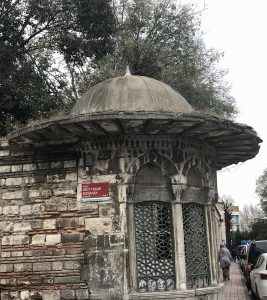
If you keep going behind the University you’ll discover a somewhat forgotten corner of the Old City around the small enclosed Kaptan-ı Derya Basmacızade İbrahim Paşa Cami, dating back to 1708. From 1935 to 1987 the mosque was decommissioned and used by the university as a reading room and storage area. Closed again after the Marmara earthquake in 1999, it has been fully restored and reopened in 2006. The small graveyard beside it is delightful as is the sebil (water dispensary) on the outside corner. Part of the complex was being used as a printshop when I visited in 2022.
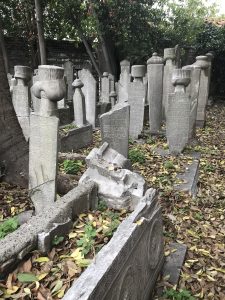
Back on Ordu Caddesi you will see a large striped brick building, the Simkeşhane, that houses the Orhan Kemal Library. There has been a building on the site since the reign of Sultan Mehmed II who established the first Ottoman mint here. Once that was relocated to the Topkapı Palace the building was taken over by silversmiths. The current building dates back in part to 1707 when Sultan Mehmed IV’s wife sponsored a rebuild after a fire.
Just west of the library is another building that was once part of a complex split asunder by the 1950s’ road widening. The Hasan Paşa Hani looks older than it actually is since it was only built in 1745 when the grand vizier Tokatlı Hasan Paşa commissioned the complex from the architect, Mustafa Çelebi.
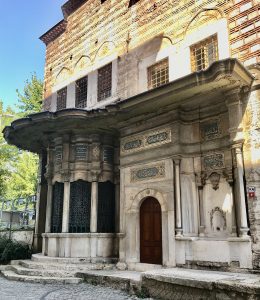
Across the road and in the alley up the steps beside the Beyazıt Hamam is the graceful Hasan Paşa Medrese with a glorious sebil and elaborate birdhouse complete with mini minarets that went with it. Today the restored han, its facade demolished by the road widening, serves as a mini bazaar while the medrese has been coopted for İstanbul University’s Institute of Turkish Studies.
If you plan to walk to Fatih from Beyazıt you should head west from the main square, passing behind the medrese/Museum of Calligraphy.
If you do this you will come out in the area known as Vezneciler behind İstanbul University’s Literature Faculty. In the grounds you will see the sebil attached to the Kuyucu Murad Pasa Medrese, dating back to 1606. Most of the rest of the medrese is obscured by the clothing stalls lining the pavement. You can also get here if you continue past the Hasan Paşa Medrese and turn left at the end of the alley.
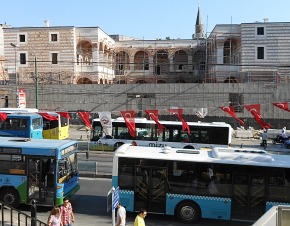 Hasan Paşa (Süpergeciler) Hanı under renovation
Hasan Paşa (Süpergeciler) Hanı under renovation
Sleeping
Antik Hotel. Tel: 0212-638 5858
Barcelo Saray. Tel: 0212-458 9800
Hotel Niles. Tel: 0212-517 3239
President Hotel. Tel: 0212-516 6980
Transport info
Beyazıt is a major transport interchange with a big tram stop in front of the Kapalı Çarşı (Grand Bazaar) and bus stands in front of Reşid Paşa’s tomb. It’s only two stops on the tram from Sultanahmet or you can easily walk here.
Nearby areas
